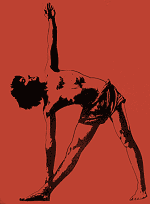 Dr. Marian Garfinkel is clinical investigator at the University of Pennsylvania Medical School. She’s written a review of yoga as a complementary therapy.
Dr. Marian Garfinkel is clinical investigator at the University of Pennsylvania Medical School. She’s written a review of yoga as a complementary therapy.
Several diseases are covered, as well as background on yoga. Let’s focus on yoga and rheumatic disease.
Actually, the available supporting data are limited to 2 studies: one in patients with osteoarthritis affecting the fingers, the other in people with carpel tunnel syndrome.
When reading the outline below, keep this in mind. Patanjali, known as “The Father of Yoga,” defined yoga as “that which restrains the thought process and makes the mind serene.” He emphasized that yoga provides a psychological approach to healing the body and achieving self-realization.
Osteoarthritis of the fingers
- 17 patients were randomly assigned to yoga or no additional treatment beyond their drugs.
- The yoga group reported significantly greater decreases in pain and tenderness and improved range of motion.
- There were no differences in grip strength or joint circumference.
Carpel tunnel syndrome
- 42 people practiced yoga to strengthen, stretch, and balance joint forces.
- A comparison group was offered a standard wrist splint.
- The yoga group reported significant benefits in grip strength.
- There was no difference in Tinel’s sign (tingling felt when the injury site was hit with a rubber hammer) or in nerve conduction times.
The bottom line?
The results of these small studies seem to support Patanjali’s view. Patients reported improvement, probably related to their psychological outlook. The improvement occurred in the absence of objective signs of any modification in the physical aspects of the condition being treated.
7/15/07 20:26 JR